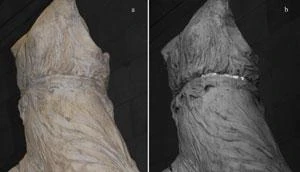Alison Abbott | 15 June 2009
Pristine white marbles were once a riot of colour.
Researchers have confirmed that the sculptures on the triangular gables of the Parthenon temple in Athens were originally brightly painted.
Conservation scientists at the British Museum in London used a non-invasive technique to reveal invisible traces of an ancient pigment known as Egyptian blue. The team says that this is the first definitive evidence that the two-metre-high sculptures were not pristine white, as they appear today, but were precisely painted — as most sculptures from antiquity once were.

The pigment, which was widely used until 800 AD, was identified on sculptures that formed parts of the decorated east and west ends of the Parthenon temple. Together with other parts of the temple, such as the frieze from within the building, they are sometimes collectively referred to as the Elgin marbles — removed by Lord Elgin, British ambassador to the Ottoman Empire from 1799–1803, and then transferred to the British Museum in 1816.
The scientists announced their findings just as the long-running feud over the ownership of the marbles has once again boiled over. The Acropolis Museum in Athens is due to be inaugurated on 20 June and was, in part, designed to house the marbles. Top delegates from the United Kingdom — including the Queen, Prime Minister Gordon Brown and Neil MacGregor, director of the British Museum — have declined to attend the opening.
The British Museum has also reiterated its standpoint on Greece’s request to repatriate the marbles, saying that it will not return any of them except on a short-term loan — and then only if Greece acknowledges the British Museum’s rightful ownership.
Antique paint
It has been known for more than two centuries that the Ancient Greeks and Romans painted their statues. That paint has almost completely disappeared over time, although tiny flecks can be found on most statues on close inspection. Unusually, no trace of paint has ever been found on the Parthenon sculptures, despite thorough analysis — including a full investigation by the renowned British physicist Michael Faraday in the 1830s.
Giovanni Verri, a physicist in the museum’s department of conservation and scientific research, developed a technique to exploit the fact that Egyptian blue emits near-infrared radiation when excited by visible light. His portable detector comprises a light-emitting diode that beams red light onto the surface being examined, and a camera that can detect the infrared light emitted by the pigment particles1.
The distribution of the pigment is also a key issue in proving that the sculptures were painted, says Verri. For example, the pigment found on the winged messenger goddess Iris traces just the belt restraining her billowing tunic (see picture, above), and nowhere else on the figure.
Greek conservators have recently observed greenish flecks on remnants of the Parthenon frieze that are in Athens, but have not reported analyses of them. “We informed our Greek colleagues of what we found,” says Verri, “and they responded warmly, saying they are interested to examine these flecks themselves.”
“I always believed the frieze must have been painted,” adds Ian Jenkins, senior curator in the British Museum’s Department of Greece and Rome. “This new method leaves no room for doubt.”
Verri thinks these frieze flecks could also be Egyptian blue, and is keen to examine them with his portable detector. But he adds that as diplomatic tensions have flared up again, now might be an insensitive time to offer.
